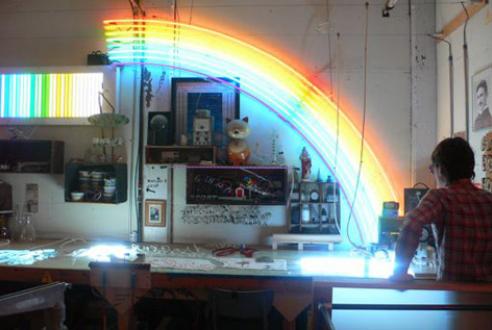Matt Dilling has no idea where his fascination with electricity came from. “I was never struck by lighting,” he says with a shrug, but he’s certain that his obsession with circuitry started at an early age. When he was three, Dilling asked his mother to decorate his birthday cake with an electrical plug made of chocolate.
Now 25, the Washington, D.C. native is one of NYC’s few-and most respected-custom neon lighting designers. His seven-year-old, Brooklyn-based company, Lite Brite Neon, has amassed a client list that includes museums, fashion designers, retail stores, pop stars and visual artists. Dilling has created neon plaid for Burberry, neon snowflakes for the Gap, neon bed pillows for Calvin Klein and a brilliant ten feet by ten feet neon logo for the art-rock band FischerSpooner.
Every neon light begins with a scale drawing, which Dilling then replicates – in reverse – by heating and bending glass tubing, a delicate skill that leaves zero margin for error. One of his five freelance employees will assemble the mount and the circuitry, and fill the tubing with the appropriate gas using a vacuum pump. Neon is in fact just one of several atmospheric gases-including helium, argon and xenon-that are used to make what we call neon signs. When electrically charged, neon gives off a red color, while argon produces a blue light. Various gases are combined with assorted colored glass tubing and phosphor coatings to create a spectrum of 50 colors.
Amazingly, all neon signs are handmade; there is no robot or machine that can bend glass. Even those ubiquitous Budweiser signs are created, sweatshop-style, in China and Hong Kong. It’s up to Dilling to take his clients’ ideas and transpose them into a shape and size that can be rendered in glass. “We get everything from that fax up there for some kid’s bar mitzvah in New Jersey”-he points to a crude drawing with the name Alec rendered like the AC/DC logo-“to blueprints that are brought over and everything’s scaled to one-sixteenth of an inch.” (Project rates start at $500 and go up to $50,000; each piece takes about two weeks to complete.)
Last year, the post-minimalist sculptor Keith Sonnier, who has been working with neon since the mid-‘60s, commissioned Lite Brite to create 15-foot tall neon tubes to line the inside lobby of the Lever House. The project was one of Lite Brite’s most prestigious jobs, and one which also illuminated why neon is considered “the bastard child of the art-glass world.” Because there is only one really well known glass craft artist, Dale Chihuly, the art-glass community feels that it hasn’t gotten its due respect; while neon, which they believe is a lesser craft form, is frequently utilized by fine artists, hence hogging more than its share of the limelight. “Keith Sonnier’s never bent a tube of neon in his life,” Dilling says. “But that doesn’t mean he’s not a great artist.”
As a decorative symbol, neon is one of the most loaded in our culture because it’s immediately associated with flash and trash. Rather than attempting to dispel these preconceptions, Dilling relishes the opportunity to play with them. “Part of what I think is so exciting about neon is that people tend to hate it because they think it’s this awful thing that can’t be done well, and that it means you live on a street with a pizzeria or a strip club.” And although that point of view is not without merit, in Dilling’s world, it’s just as likely that someone is referencing that aesthetic. Take, for example, Stella McCartney, for whose shop Dilling made a sign reading Girls Girls Girls.
Because so many of Dilling’s clients hail from the fashion and art worlds, their points of reference change with every season. “They’re into [neon] one month because they think it’s a formal and beautiful thing, and they’re into it the next month because they think it’s seedy.”
According to Dilling, areas the general public traditionally thinks of as “meccas of neon,” such as Times Square or Las Vegas, have “followed the trajectory of what’s popular in advertising.” He estimates that less than one percent of the signs currently lighting up 42nd Street are neon, most having been replaced by fiber optics and LED signboards. As he points out, with an LED signboard you can flash 200 messages in an hour, but with neon you’re limited to one message.
In the neon workshops that he teaches two or three times a year, Dilling gladly shares the vast stores of knowledge he carries around in his head. “Over two days we go from zero to 60 of neon information,” he says. Students will learn how to design a project, and will eventually try their hand at the bending and building of a small piece. “Simpler is better,” he advises, noting that he finds himself constantly surprised by his students’ creativity. “It’s really this full spectrum of people who come in and want to do things you’ve never seen with neon, so that’s a really great part of it.”



